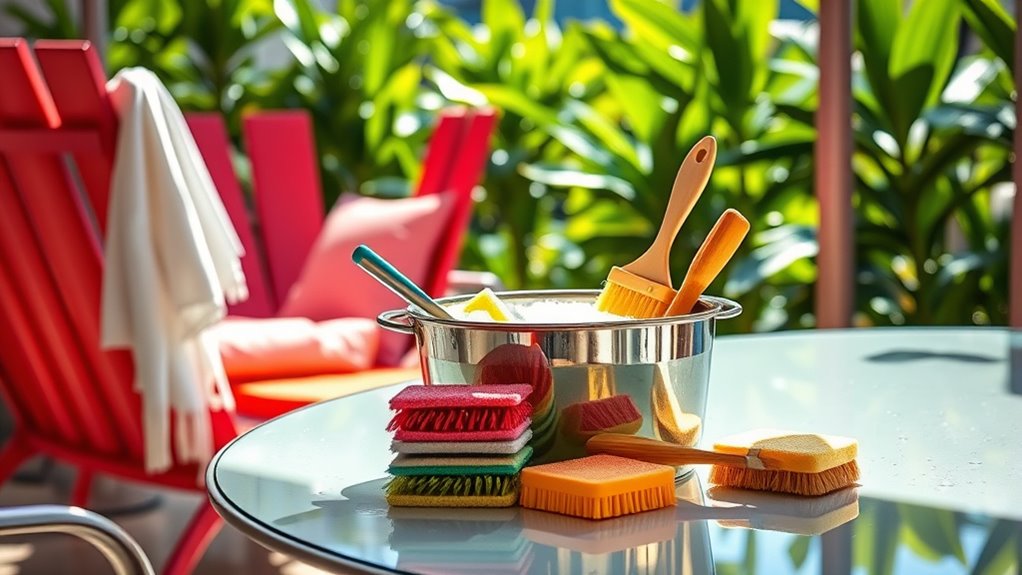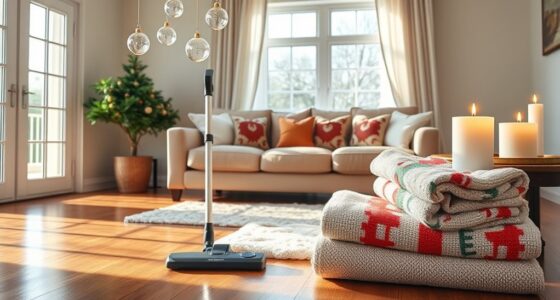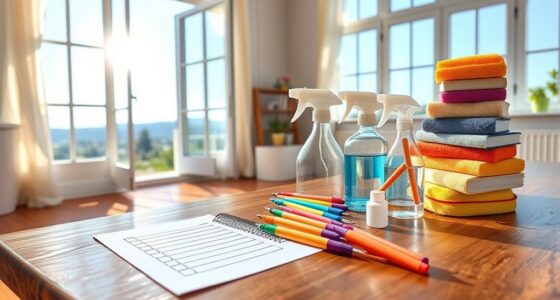To clean your outdoor furniture before summer, start by gathering gentle dish soap, a bucket of warm water, and soft-bristled brushes. Scrub surfaces according to their material; for metal, use soapy water and apply wax to prevent rust. Clean wooden furniture with soap and treat it with UV inhibitors. Don’t forget to address cushions by brushing off debris and rinsing them. Want to learn how to tackle mold and rust, or maintain your furniture longer?
Key Takeaways
- Gather necessary supplies like warm soapy water, soft-bristled brushes, microfiber towels, and a garden hose for effective cleaning.
- Clean different materials accordingly: use soapy water for plastic, apply paste wax on metal, and vacuum wicker furniture.
- Address mold and stains by scrubbing with vinegar or using a diluted bleach solution for tougher spots.
- Inspect furniture for rust, cracks, or mold, and treat any issues promptly to prolong lifespan.
- Maintain furniture regularly, clean at least once a season, and use protective covers during the off-season.
Importance of Cleaning Outdoor Furniture
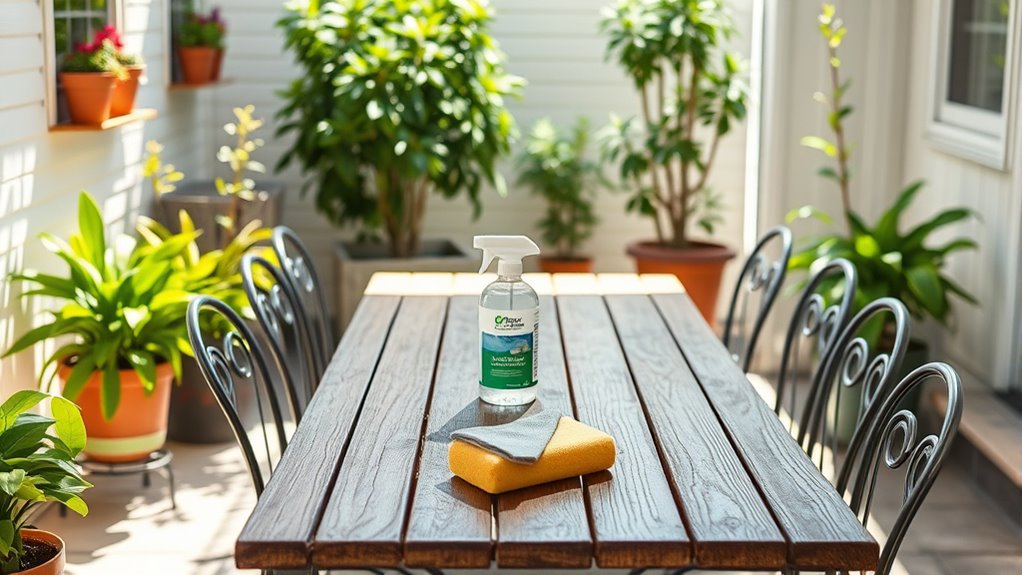
Cleaning your outdoor furniture is essential, especially as summer approaches. It helps remove dirt, mold, and mildew that accumulate during the winter months, ensuring you have a fresh and inviting space for relaxation and entertaining. Regular cleaning not only enhances the aesthetic appeal of your outdoor living areas but also extends the lifespan of your furniture by preventing damage from harsh weather and organic debris. Neglecting this task can lead to unsightly stains and deterioration, which can be costly to repair or replace.
Establishing a regular cleaning routine promotes a healthier outdoor environment by minimizing allergens and pests. Additionally, maintaining clean outdoor spaces can contribute to better overall well-being, as fresh air is crucial for a healthy lifestyle. Regular cleaning also reduces allergens and pollutants, creating a more enjoyable atmosphere for gatherings and activities during the sunny months ahead. By keeping your outdoor furniture clean, you create a welcoming atmosphere for gatherings and activities during the sunny months ahead. Moreover, a clean space encourages mindfulness and focus, enhancing your overall enjoyment of the outdoors. Regular maintenance also fosters a clutter-free space, which is important for creating a tranquil outdoor oasis.
Tools and Supplies Needed for Cleaning
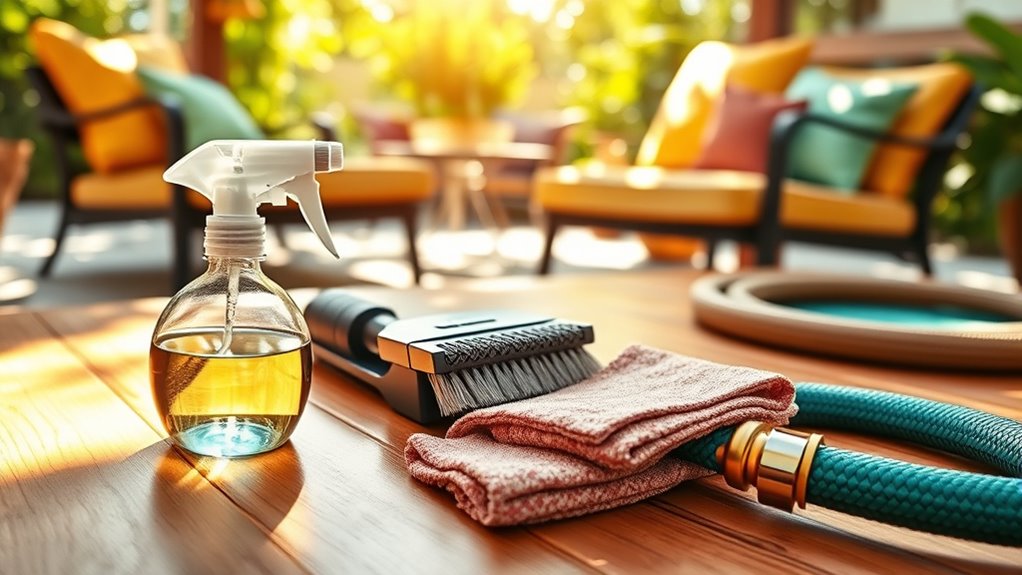
To tackle the task of cleaning your outdoor furniture effectively, you’ll need a few key tools and supplies. Start by gathering a bucket of warm water mixed with gentle dish soap for safe cleaning.
Here’s what else you’ll find helpful:
- Soft-bristled brushes in various sizes for scrubbing different surfaces.
- A garden hose to rinse off soap and dirt easily.
- Microfiber towels for drying and preventing water spots. Incorporating weather-resistant materials in your outdoor furniture will help maintain its durability during the cleaning process. Additionally, remember that regular cleaning can prevent running dry of your outdoor gear, ensuring it stays in optimal condition. Furthermore, establishing designated zones for your outdoor items can make cleaning and organizing more efficient.
Don’t forget to have a vacuum with a crevice attachment for removing dirt and debris from your cushion covers and those hard-to-reach spots. Regular cleaning can enhance the appearance and longevity of the canvas in your pop-up camper, ensuring all your outdoor gear stays in great condition.
With these tools ready, you’ll be all set to refresh your outdoor space in no time!
Step-by-Step Guide for Cleaning Different Materials
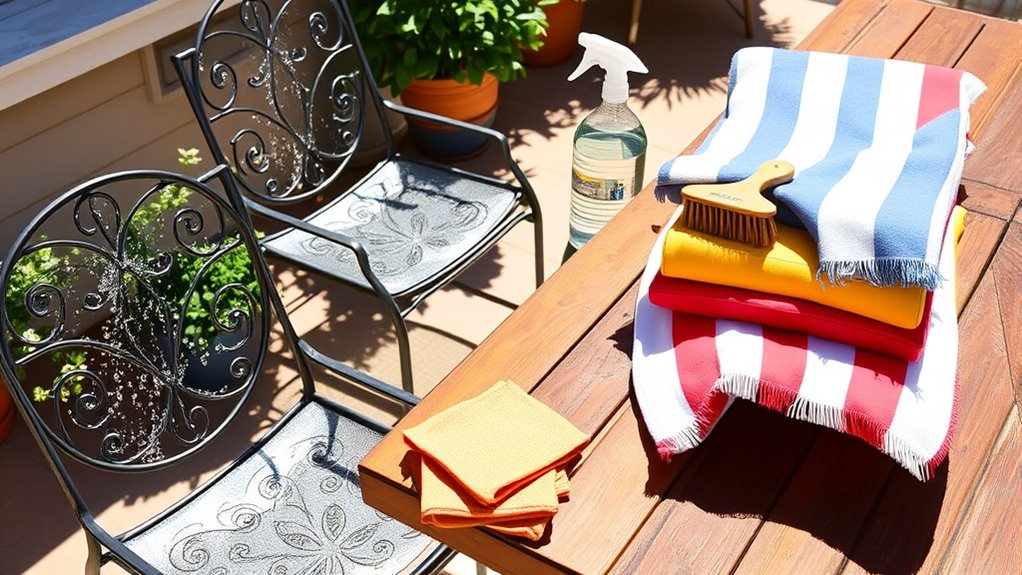
When it comes to maintaining your outdoor furniture, knowing how to clean different materials effectively can make a significant difference in their longevity and appearance.
For plastic and resin furniture, mix an all-purpose cleaner or soapy water, then rinse thoroughly with a hose.
Metal patio furniture, like wrought iron, needs a soapy water wash, a rinse, and a treatment with paste wax to prevent rust.
Wicker furniture benefits from regular cleaning with a microfiber cloth and vacuuming, while deep cleaning can be done with a steam cleaner.
Wooden furniture, such as teak, should be cleaned with soapy water, rinsed, and treated with UV inhibitors. Regular maintenance can also extend appliance lifespan and enhance the durability of your outdoor pieces.
For outdoor cushions, brush off debris, spot-clean, and rinse to prevent mildew.
Tips for Maintaining Outdoor Furniture Longevity
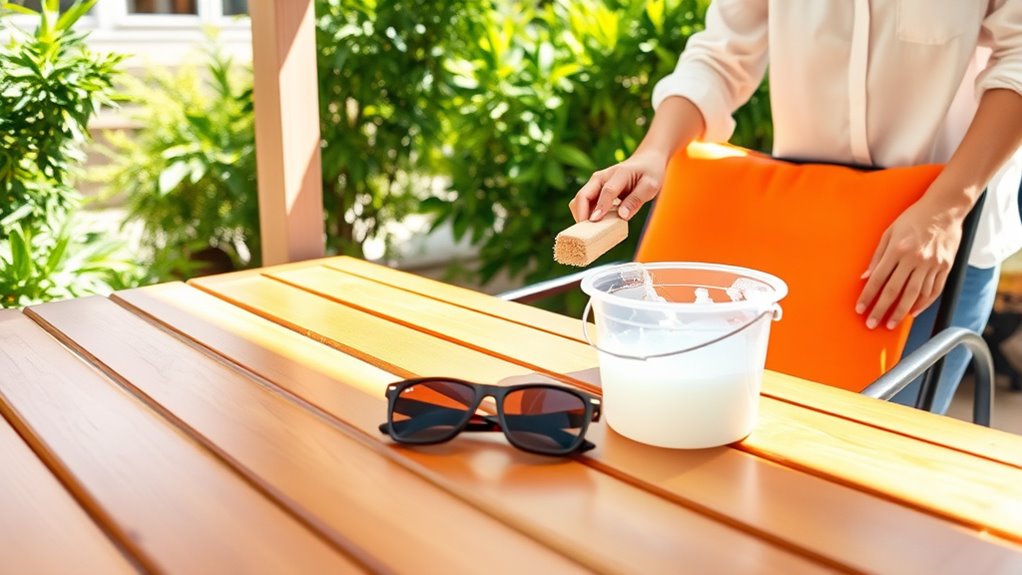
Maintaining the longevity of your outdoor furniture requires consistent care and attention. To keep your outdoor living spaces in top shape, follow these tips:
Consistent care is essential for preserving the lifespan of your outdoor furniture and keeping your spaces inviting.
- Clean your patio furniture at least once a season to prevent mold, mildew, and dirt buildup.
- Use protective covers during the off-season to shield your furniture from harsh weather, which extends its lifespan. Regular maintenance not only improves aesthetics but also enhances user experience by making your outdoor area more inviting. Additionally, incorporating natural materials in your outdoor furniture can provide a rustic charm while promoting tranquility.
- For outdoor metal furniture, inspect and address rust promptly to maintain structural integrity. Regular maintenance can also help improve energy efficiency by ensuring that outdoor appliances and lighting operate effectively.
Additionally, choose materials with low maintenance requirements, like aluminum or all-weather wicker, to reduce cleaning frequency.
For wood furniture, maintain a layer of exterior-grade varnish and apply oils every few months to resist moisture and UV damage. Regular cleaning can also help mitigate risks, as homes without security systems are 300% more likely to be burglarized, which highlights the importance of securing your outdoor spaces.
Addressing Common Issues: Mold, Rust, and Stains

When it comes to outdoor furniture, you’ll likely encounter mold, rust, and stains at some point. Tackling these issues promptly can save your furniture from further damage and keep it looking great. Let’s explore effective techniques for mold removal, rust prevention, and stain treatment solutions. Additionally, just as Tesla’s fire rate is lower than that of gasoline vehicles, maintaining your outdoor furniture can significantly extend its lifespan and reduce the need for replacements. Regular cleaning and maintenance, similar to cleaning paint sprayers, are essential for preserving the quality of your outdoor pieces. Furthermore, just like the importance of sustainable practices in reducing environmental impacts, keeping your outdoor furniture clean helps maintain its aesthetic appeal and functional longevity. Proper maintenance can also enhance your furniture’s durability, much like the way efficient wood stoves support eco-friendly living through reduced emissions.
Mold Removal Techniques
Mold on outdoor furniture can be a frustrating issue, but tackling it effectively is key to preserving your furniture’s lifespan. Start by scrubbing affected areas with full-strength white vinegar and a hard brush, ensuring everything is dry before cleaning. To protect your skin while cleaning, it’s essential to use broad-spectrum sunscreen to shield against UV rays, especially during peak sun hours. Additionally, keeping your outdoor furniture in a location with proper ventilation can help reduce moisture buildup, further minimizing mold growth. Regular maintenance of outdoor furniture, including cleaning filters when using air purifiers, can also contribute to a healthier environment.
For stubborn mold, you can use a diluted bleach solution (1 part bleach to 3 parts water) after testing it on an inconspicuous spot. To keep mold at bay, consider these tips:
- Perform regular inspections, especially after rainy or humid weather.
- Store outdoor furniture in a dry location during the off-season and use protective covers.
- Clean wood furniture regularly with soapy water and apply a UV inhibitor to maintain its integrity. Additionally, using natural remedies like vinegar can help inhibit mold growth on surfaces.
Rust Prevention Methods
To keep your outdoor metal furniture looking great and free from rust, regular inspections are essential. Check for any signs of rust and address them promptly. If you spot rust, scrub it with a cloth soaked in vinegar, then repaint or seal with outdoor-safe paint to prevent further deterioration. For non-rust-resistant metals, apply paste wax to create a protective barrier against moisture and rust formation. Additionally, using robust cleaning equipment can enhance the effectiveness of your maintenance routine. Regular cleaning can be achieved with robot vacuum cleaners that can easily access outdoor areas. Storing or covering your furniture during harsh weather and winter months to minimize exposure that can cause rust buildup is important for senior safety and fraud prevention. Additionally, regular cleaning schedules can help prevent dirt and grime accumulation that may lead to rust.
Stain Treatment Solutions
Outdoor furniture can face a variety of stains and issues that detract from its appearance and longevity.
Here are some effective stain treatment solutions to tackle common problems:
- For mold and mildew, scrub affected areas with a mix of full-strength white vinegar and a hard brush, or a diluted bleach solution—always test first! Regular cleaning can help maintain freshness of materials.
- Rust can be removed by soaking a cloth in vinegar, wrapping it around rust spots, and scrubbing with a stiff brush. Protect with paste wax or rust-resistant paint afterward.
- Oil-based stains? Sprinkle flour or cornstarch to absorb the grease, then follow up with a gentle cleaning solution.
Additionally, consider using essential oils like tea tree oil for their natural antibacterial properties to help prevent mold and mildew from returning.
Regular inspections and prompt treatment can help extend the lifespan of your outdoor furniture.
Don’t let tough stains ruin your summer!
Best Practices for Cleaning Outdoor Cushions
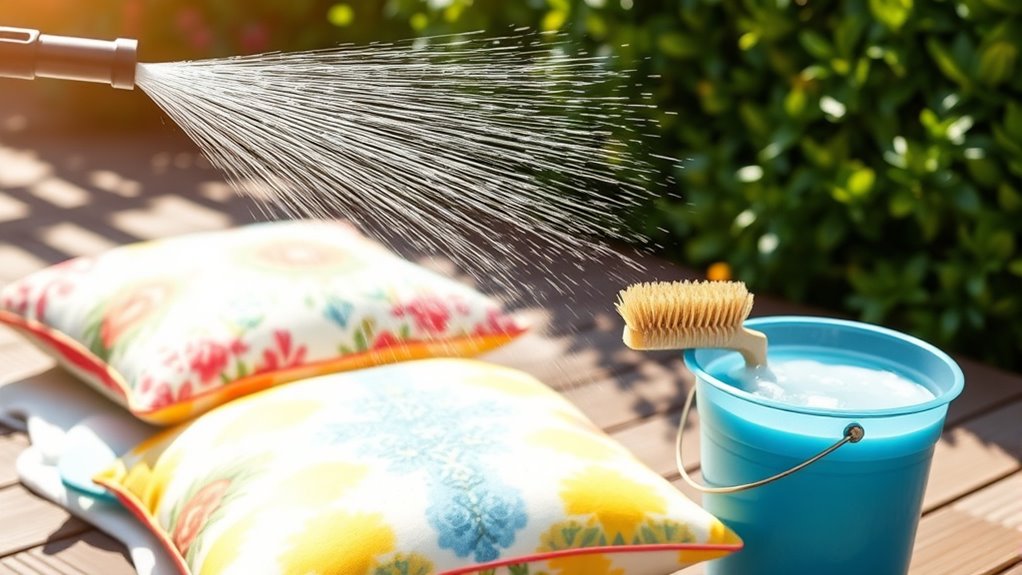
When it comes to keeping your outdoor cushions looking fresh, starting with the right cleaning approach is essential.
First, check if your cushion covers are removable. If they are, follow the manufacturer’s instructions for washing.
Check if your cushion covers can be removed and follow the manufacturer’s washing instructions for the best results.
For non-removable covers, vacuum them with a crevice attachment to remove dust before spot cleaning.
For stubborn stains, mix 1/4 cup of mild detergent with a gallon of warm water, and apply it gently using a soft-bristled brush in circular motions.
To tackle mold or mildew, use a bleach-water mixture, but test it first on a hidden area.
Once done, rinse your cushions thoroughly with a garden hose, and let them dry completely in a well-ventilated space to prevent moisture buildup.
Preparing Your Furniture for Summer Use

As summer approaches, it’s important to prepare your furniture for the season ahead. Start by giving your outdoor furniture a thorough clean to enhance its appearance and make sure it’s ready for gatherings.
Follow these steps for effective maintenance:
- Use a soft brush or cloth to remove dust and debris.
- Clean different materials properly: use soapy water for metal and wood, and a mild bleach-water solution for mold on plastic or resin.
- Inspect for rust, cracks, or mold, addressing any issues promptly.
Finally, secure your furniture by tightening screws and lubricating joints.
When not in use, store or cover it to protect against harsh weather elements. With these preparations, your outdoor furniture will be ready for summer fun!
Frequently Asked Questions
How Do You Clean Outdoor Furniture After Winter?
To clean your outdoor furniture after winter, start by removing dust and debris with a brush or cloth.
For plastic or resin pieces, use an all-purpose cleaner or a bleach-water mix to eliminate mold.
Clean metal furniture with soapy water and treat any rust spots immediately.
For wicker, gently vacuum or use a microfiber cloth, and consider steam cleaning for tougher stains.
Wood, especially teak, should be washed with soapy water and oiled regularly.
What Is the Best Solution for Cleaning Outdoor Furniture?
Cleaning outdoor furniture is like giving a revitalizing touch to your backyard.
For the best solution, mix gentle soap with warm water to tackle everyday dirt. If you’ve got stubborn stains, a bleach-water mixture can work wonders—just test it first.
For plastic, an all-purpose cleaner or hose spray does the trick, while wicker needs a soft brush.
How Do You Prevent Mold and Mildew on Outdoor Furniture?
To prevent mold and mildew on your outdoor furniture, make sure it’s completely dry before covering or storing it.
Use breathable, waterproof covers to reduce moisture buildup.
Regularly clean your furniture with a bleach-water solution, but always test it on a small area first.
Opt for outdoor fabrics treated with mold-resistant coatings, and store your furniture in a dry, well-ventilated space during off-seasons, elevating it off the ground to minimize moisture contact.
Should You Scotchgard Outdoor Furniture?
Imagine your outdoor furniture sitting like a sun-kissed gem, inviting you to relax. Yes, you should absolutely Scotchgard your outdoor furniture.
This magic spray creates a protective barrier, helping to repel spills and stains like an invisible shield. It keeps your cushions looking vibrant and fresh, fighting off mold and fading.
Just make sure the fabric’s clean and dry before application, and you’ll extend the life of your beloved outdoor oasis beautifully.
Conclusion
So, now that you’ve scrubbed, polished, and de-stained your outdoor furniture, you’re ready to bask in the sun like a well-prepped lobster. Who knew that cleaning could be such a workout? Just remember, while you’re sipping lemonade, it’s your furniture that deserves the real credit for your summer aesthetic. After all, it’s not like they’re going to clean themselves—unless they’ve formed a union. So, go ahead, enjoy the fruits of your labor—and don’t forget the sunscreen!

